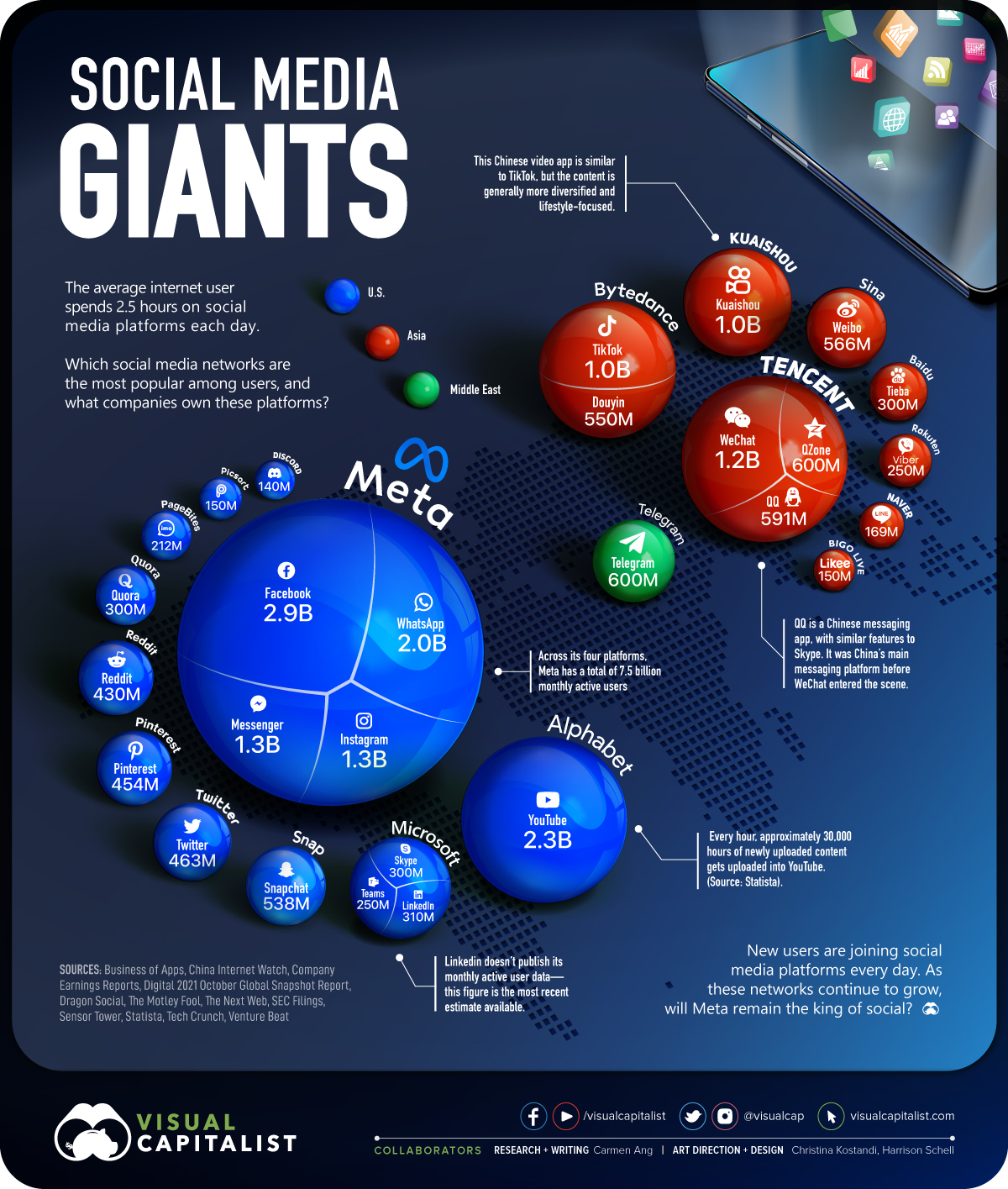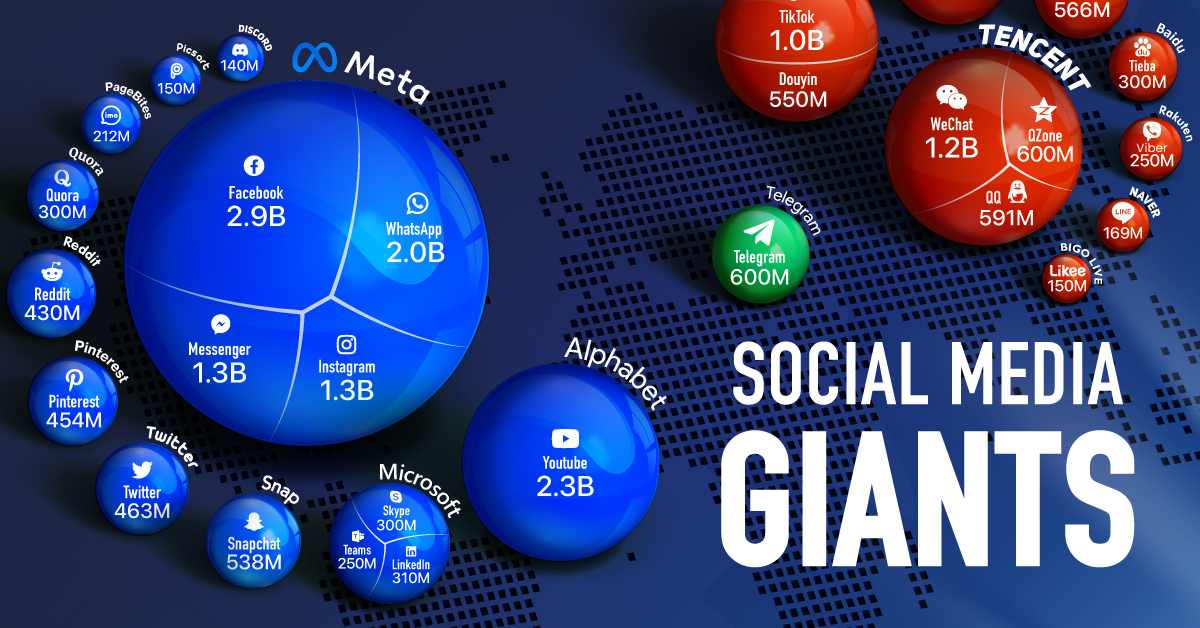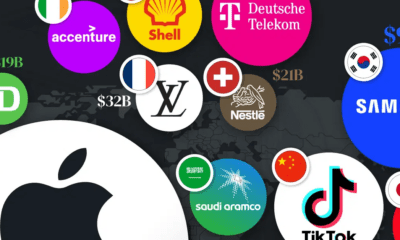Technology
Ranked: The World’s Most Popular Social Networks, and Who Owns Them

The World’s Most Popular Social Networks, and Who Owns Them
Currently, there are over 4.5 billion people around the world who use some form of social media—about 57% of the global population.
Yet, while social media’s audience is widespread and diverse, just a handful of companies control a majority of the world’s most popular social media platforms. Meta, the tech giant formerly known as Facebook, owns four of the five most widely used platforms.
This graphic highlights the biggest social networks across the globe, measured by their monthly active users (MAUs).
Note: We’ll be using terms like “social network” and “social platform” interchangeably to refer to various messaging, video, and image-sharing platforms that have social attributes built in.
Top Social Platforms by Monthly Active Users
To measure each platform’s MAUs, we dug into various sources, including the most recent company SEC filings, and quarterly earnings reports.
A majority of Meta’s user base comes from its most popular platform, Facebook—the social media giant currently has around 2.9 billion MAUs worldwide.
| Rank | Platform name | Parent company | Country | Monthly active users, in millions |
|---|---|---|---|---|
| #1 | Meta | 🇺🇸 U.S. | 2,910 | |
| #2 | YouTube | Alphabet | 🇺🇸 U.S. | 2,291 |
| #3 | Meta | 🇺🇸 U.S. | 2,000 | |
| #4 | Messenger | Meta | 🇺🇸 U.S. | 1,300 |
| #5 | Meta | 🇺🇸 U.S. | 1,287 | |
| #6 | Tencent | 🇨🇳 China | 1,225 | |
| #7 | Kuaishou | Kuaishou | 🇨🇳 China | 1,000 |
| #8 | TikTok | Bytedance | 🇨🇳 China | 1,000 |
| #9 | Telegram | Telegram | 🇦🇪 UAE | 600 |
| #10 | Qzone | Tencent | 🇨🇳 China | 600 |
| #11 | Tencent | 🇨🇳 China | 591 | |
| #12 | Sina | 🇨🇳 China | 566 | |
| #13 | Douyin | Bytedance | 🇨🇳 China | 550 |
| #14 | Snapchat | Snap | 🇺🇸 U.S. | 538 |
| #15 | 🇺🇸 U.S. | 463 | ||
| #16 | 🇺🇸 U.S. | 454 | ||
| #17 | 🇺🇸 U.S. | 430 | ||
| #18 | Microsoft | 🇺🇸 U.S. | 310 | |
| #19 | Quora | Quora | 🇺🇸 U.S. | 300 |
| #20 | Skype | Microsoft | 🇺🇸 U.S. | 300 |
| #21 | Tieba | Baidu | 🇨🇳 China | 300 |
| #22 | Viber | Rakuten | 🇯🇵 Japan | 250 |
| #23 | Teams | Microsoft | 🇺🇸 U.S. | 250 |
| #24 | imo | PageBites | 🇺🇸 U.S. | 212 |
| #25 | Line | Naver | 🇰🇷 South Korea | 169 |
| #26 | Picsart | Picsart | 🇺🇸 U.S. | 150 |
| #27 | Likee | Bigo Live | 🇸🇬 Singapore | 150 |
| #28 | Discord | Discord | 🇺🇸 U.S. | 140 |
Where in the world are Facebook users located? The platform’s biggest user base comes from India, with an audience size of almost 350 million. Its second-largest user base is the United States, with 193.9 million users, while Indonesia comes in third with 142.5 million.
But Facebook isn’t the only social giant in Meta’s network of platforms. WhatsApp has approximately 2 billion MAUs, making it Meta’s second-largest platform, and the third-largest social network overall.
Like Facebook, a significant number of WhatsApp users are located in India, with roughly 390 million users. Brazil has a large portion of WhatsApp users as well, with an audience size of 108 million.
The Billion Users Club
Meta currently dominates the social network landscape, with a combined total of 7.5 billion MAUs across all four of its platforms. However, a few other companies also hit the one billion MAU mark across all their platforms on the list:
| Rank | Parent company | # of companies on the list | Country | Combined MUAs |
|---|---|---|---|---|
| 1 | Meta | 4 | 🇺🇸 U.S. | 7.5 billion |
| 2 | Tencent | 3 | 🇨🇳 China | 2.4 billion |
| 3 | Alphabet | 1 | 🇺🇸 U.S. | 2.3 billion |
| 4 | Bytedance | 2 | 🇨🇳 China | 1.6 billion |
| 5 | Kuaishou | 1 | 🇨🇳 China | 1 billion |
After Meta, Tencent has the second-highest reach thanks to its three platforms—WeChat, Qzone, and QQ. Of the three, WeChat is currently the most popular. On average, WeChat users send about 45 billion messages a day.
Third on the list is Alphabet, thanks to its one platform, YouTube. Founded in 2005, this video streaming platform currently has over 50 million content creators, who share approximately 500 hours of video content every minute.
Close behind Alphabet is Bytedance, with a combined 1.6 billion MAUs across its two platforms—Douyin and its international counterpart TikTok. While the apps share a lot of similarities, they function as completely separate entities, with different registration, content policies, and regulations.
Global Social Networks? Not Always
While social media networks often transcend country borders, it’s worth noting that the online realm does not completely escape the constraints and regulations of our physical world.
Since 2009, Facebook has been banned in China for not complying with censorship rules. Facebook was also blocked in Iran and Syria around the same time and has been blocked sporadically since.
In 2020, the Trump administration tried to enact a similar ban against TikTok, but the order was blocked by a federal judge and eventually revoked by the Biden administration a year later.
Despite various bans and roadblocks, it’s clear that social media platforms have seeped into the lives (and onto the screens) of users across the globe. And as internet access worldwide continues to grow, so too will the number of social media users.
Brands
How Tech Logos Have Evolved Over Time
From complete overhauls to more subtle tweaks, these tech logos have had quite a journey. Featuring: Google, Apple, and more.

How Tech Logos Have Evolved Over Time
This was originally posted on our Voronoi app. Download the app for free on iOS or Android and discover incredible data-driven charts from a variety of trusted sources.
One would be hard-pressed to find a company that has never changed its logo. Granted, some brands—like Rolex, IBM, and Coca-Cola—tend to just have more minimalistic updates. But other companies undergo an entire identity change, thus necessitating a full overhaul.
In this graphic, we visualized the evolution of prominent tech companies’ logos over time. All of these brands ranked highly in a Q1 2024 YouGov study of America’s most famous tech brands. The logo changes are sourced from 1000logos.net.
How Many Times Has Google Changed Its Logo?
Google and Facebook share a 98% fame rating according to YouGov. But while Facebook’s rise was captured in The Social Network (2010), Google’s history tends to be a little less lionized in popular culture.
For example, Google was initially called “Backrub” because it analyzed “back links” to understand how important a website was. Since its founding, Google has undergone eight logo changes, finally settling on its current one in 2015.
| Company | Number of Logo Changes |
|---|---|
| 8 | |
| HP | 8 |
| Amazon | 6 |
| Microsoft | 6 |
| Samsung | 6 |
| Apple | 5* |
Note: *Includes color changes. Source: 1000Logos.net
Another fun origin story is Microsoft, which started off as Traf-O-Data, a traffic counter reading company that generated reports for traffic engineers. By 1975, the company was renamed. But it wasn’t until 2012 that Microsoft put the iconic Windows logo—still the most popular desktop operating system—alongside its name.
And then there’s Samsung, which started as a grocery trading store in 1938. Its pivot to electronics started in the 1970s with black and white television sets. For 55 years, the company kept some form of stars from its first logo, until 1993, when the iconic encircled blue Samsung logo debuted.
Finally, Apple’s first logo in 1976 featured Isaac Newton reading under a tree—moments before an apple fell on his head. Two years later, the iconic bitten apple logo would be designed at Steve Jobs’ behest, and it would take another two decades for it to go monochrome.
-

 Maps1 week ago
Maps1 week agoThe Largest Earthquakes in the New York Area (1970-2024)
-

 Money2 weeks ago
Money2 weeks agoWhere Does One U.S. Tax Dollar Go?
-

 Automotive2 weeks ago
Automotive2 weeks agoAlmost Every EV Stock is Down After Q1 2024
-

 AI2 weeks ago
AI2 weeks agoThe Stock Performance of U.S. Chipmakers So Far in 2024
-

 Markets2 weeks ago
Markets2 weeks agoCharted: Big Four Market Share by S&P 500 Audits
-

 Real Estate2 weeks ago
Real Estate2 weeks agoRanked: The Most Valuable Housing Markets in America
-

 Money2 weeks ago
Money2 weeks agoWhich States Have the Highest Minimum Wage in America?
-

 AI2 weeks ago
AI2 weeks agoRanked: Semiconductor Companies by Industry Revenue Share


















